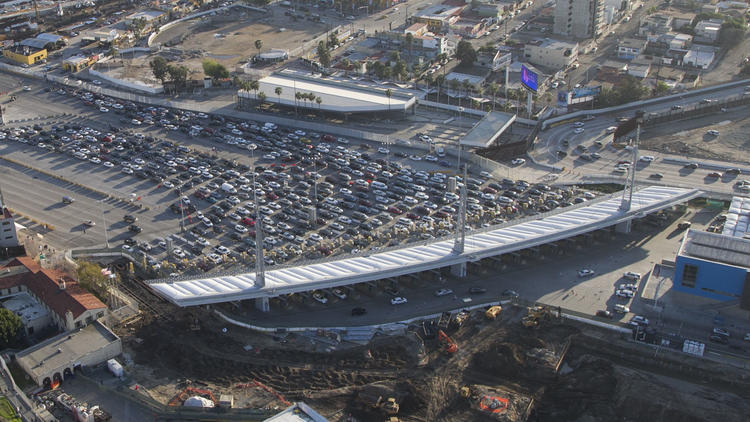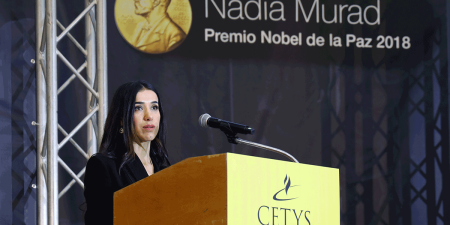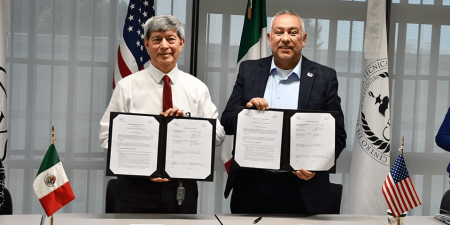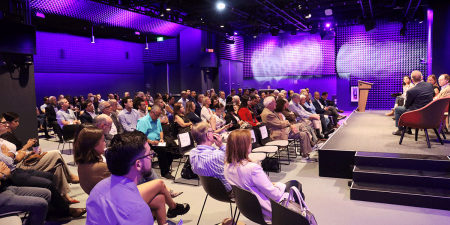While President Trump has not yet moved to deport students who are unauthorized immigrants, Mexican education officials already are preparing for it.
The officials acknowledge it’s uncertain whether Trump will take such action, but that the threat is very real.
“We don’t know how many may come,” Rodrigo Guerra-Botrello, the second secretary general the Mexican Federation of Private Institutions of Higher Education, said about a possible influx of students from the north.
“It’s a common concern,” said Guillermo Hernández, general director for strategic partnership with the National Association of Universities and Institutions of Higher Education in Mexico. “We hope that nothing is going to happen. However, we are preparing to receive those deported students.”
Short of deportations, the unauthorized students could also head south if Trump takes away their government student aid, they said.
The two men and other educators from around the world were at San Diego State University Friday morning for the start of the three-day International Association of University Presidents conference.
University leaders from several countries visited SDSU and the University of San Diego and were scheduled to visit CETYS University in Tijuana and Ensenada on Saturday.
On the opening day, CETYS University President Fernando León-García said educators are staying positive in light of the possibility that they soon may have to find room for an unknown number of students heading across the border.
Still, he said, they are not moving ahead blindly. CETYS and other universities are working with politicians to streamline the onerous process of transferring units from American schools and also studying how to help those students with financing, he said.
Hernández said his association has been asking higher education institutions how much room they have in different disciplines as a way of preparing for a wave of new students.
On the U.S. side of the border, colleges and universities have reported many students are anxious about possible changes to immigration laws and DACA — Deferred Action for Childhood Arrivals — a federal act that allows young people who are brought to the country illegally as minors to stay if they are in school and keep out of trouble.
Students also could be affected by changes to the California Development, Relief and Education for Alien Minors (DREAM) Act, which allows children brought to the U.S. as minors without proper visas or immigration documents to apply for student aid if they have attended school on a regular basis.
Trump already has signed executive orders aimed at cracking down on unauthorized immigration and blocked refugees from certain countries from entering the U.S. But so far there has been no indication about when or if he will take actions affecting immigrant students.
“We don’t know what he may do next,” Guerra-Botrello said.
There also is no way of knowing how many students would continue their education in Mexico if they do have to leave, but Guerra-Botrello said the Federation of Private Institutions of Higher Education already is preparing for them.
To streamline the process, he said a new law passed Wednesday allows private schools to review and enroll students, steps that in the past were done by government officials. The change gives private universities, which serve about 20 percent of Mexican students, the same enrollment power as public schools, he said.
Mexico Sen. Víctor Hermosillo, a member of the federal government’s Education Commission, said politicians south of the border are working to create a law within 30 days to protect Mexican students who may be deported from the United States.
Specifically, he said the law would guarantee those students have the same rights as all Mexico citizens to attend schools in the country for free.
Hermosillo estimated there may be 100,000 unauthorized immigrant students from Mexico in American schools from kindergarten through college.
“We have to answer how are we going to find a place for them in our schools,” he said.
Hermosillo, León-García and other Mexican officials also plan to meet with California legislators Feb.15 to discuss education, immigration and other border issues.
While state officials may be helpless to stop federal orders regarding immigration, Hermosillo said the meetings could lead to both sides working together to make any transition facing students run smoothly.
He also hopes the meetings will create better relations between the two countries.
“We’re going to have more of a relationship with the United States,” he said. “There is a lot of misunderstanding.”
Hernández, whose association represents 100 of the top public and private institutions and research centers in Mexico, said he worries that deportations or other changes in immigration laws could stall the improved relations he has seen building between educators in the two countries over the past three years.
“I think it’s a shame, because there are so many things to do,” he said. “We need to know more from each other and understand from each other.”
Both Hermosillo and Hernández said the U.S. needs to have a better understanding of the contribution of Mexican immigrants.
“There are 300,000 Mexicans with graduate degrees working in the U.S.,” he said. “Mexico is not necessarily sending bad people. They’re sending good people.”
Despite the concerns, León-García said relations between schools on both sides of the border will remain solid.
“The communications and collaboration between universities are so strong that it would be very difficult for walls to stop them,” he said.
.León-García said collaborations include professors from SDSU teaching in at CETYS and engineering students at UC San Diego interning at a high-end electronics firm in Mexicali.
But changes on the border, whether a wall or increased security, could have consequences, he said.
About 350 students in the U.S. regularly cross the border to classes at CETYS in Tijuana and Mexicali, he said. Border waits already are long, and if they become even longer, León-García said it might discourage students from attending the school.
Source The San Diego Union Tribune









Leave your comment